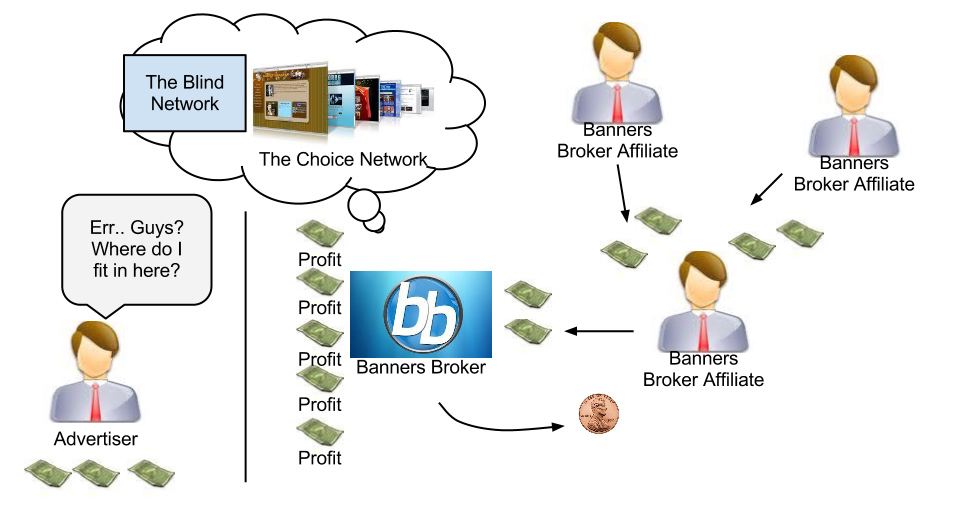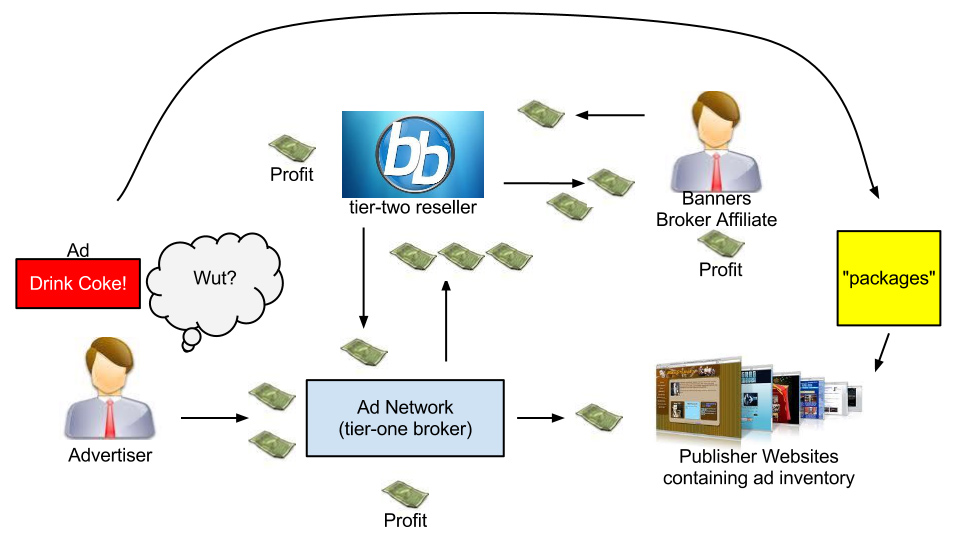Introduction
After writing my first post on Banners Broker, and being surprised by its popularity, I have decided to post a follow up, to address a criticism I have encountered when speaking to those who are in favour of Banners Broker. Specifically, I have been told that the example of earnings from the Green panel was taken from an outdated, unofficial document, and therefore I should not base my criticism on the figures extrapolated from that source. I have also been directed to this article written by Terry Stern, International PR Director of Stellar Point. I had come across this document a few weeks earlier, when it was forwarded to me from a friend who received it from a Banners Broker affiliate looking to get him involved. So it seems like there’s at least some agreement that this is ‘official’ information, and therefore a good target for further analysis. If you have not read this before, I recommend you do so, as I will cite parts of it throughout this piece.
Okay, so what is Banners Broker, really?
In my first post I drew comparisons between Banners Broker and Google because not only is Google a very well-known example of a successful advertising broker, it is also used by proponents of Banners Broker to demonstrate how much money there is to be made in this industry. I have seen many, many explanations by affiliates which state that Banners Broker is “like Google”. As I pointed out in my original post, Google’s business model is basically very simple:
Website owner (or publisher): “Lots of people visit my site. I’d like to earn some money by having advertisers place ads on my site.”
Advertiser: “I have a product or service I want to promote. I’d like to place ads for it on websites that get a lot of visitors. I’ll pay for it, of course.”
Google: “Hi, guys. We’ll hook you up. For our trouble, we’ll pay the publisher a little less than we charge the advertiser. Kerching!”
So, given the explanations of Banners Broker that I had heard before, I took a look at how Banners Broker might fit into this model. I found that it didn’t work. I won’t explain it again – read the first post.
But it turns out that I was wrong! In the document that will be at the centre of this article, Terry Stern explains the actual workings of Banners Broker. Let’s now go on a journey, down, down the rabbit hole.
Banners Broker International, is an online broker of web ad space and traffic impressions. We are NOT an advertising company, nor do we actively solicit advertising from companies. We offer an access point to companies looking to advertise online through their website, but, don’t get involved in the actual process other than to provide access to the brokers we deal with.

Okay, lets start with this statement. Immediately, there is a problem. Read again the second sentence. Now look at this picture: It’s the first slide from the “Main Presentation” which is available to affiliates through their dashboard on bannersbroker.com (yes, I’ve got an account, and I watched all the powerpoints). Do you see a discrepancy?
All right, I’ll give them the benefit of the doubt and assume that the slide is old and someone forgot to update it to bring it into line with the new model. Mr. Stern also states, “nor do we actively solicit advertising from companies.” This, however, is not consistent with the fact that the homepage of bannersbroker.com offers, as one of the three main services, the Advertiser package, and elsewhere states: “After purchasing a preset number of impressions, we place your ads on various publishers’ websites and monitor them daily to ensure their success.” And finally, go here and listen to what the annoying man has to say.
Again, let’s give Mr. Stern the benefit of the doubt, since he is at pains to explain how, “You’re also going to have to start all over and use different eyes if you’re going to want to understand who BBI is and how it works.” Alright, let’s insert our different eyes and dive a little deeper.
The ad space BBI purchases, is done through the broker’s we deal with who own reseller programs, however, BBI isn’t restricted to the specific terms those agreements state, due to a unique system created by Chris Smith.
So, he seems be saying that Banners Broker is actually a broker that brokers between advertisers and other brokers. Following? Am I understanding this right? Please clarify, Mr. Stern.
So the broker is tier one in this instance, and reseller (BBI for example) is a tier two, and any affiliates would be tier three. So the tier one broker sells space to the advertiser at market price, passes remnant inventory to the tier two resellers at a discount and pays them a discounted rate on servicing that inventory, who discount it even further and pay the tier three affiliate who purchases the ad space through packages. This is where BBI makes the bulk of their revenues, and how it can afford to pay an affiliate up-to twice the initial inventory purchase value back as commission and still earn a profit themselves.
I’m afraid my only response to this paragraph was “WTF?!” I read it and re-read it. My head felt like it was full of cotton wool. I needed to know a bit more about this whole thing. I found a couple of really great articles covering the basics of online advertising, the first of which clearly explains the value chain, and defines the product of this industry, and the second that explains exactly how ad networks come into it, and how they make their money. If you, like me, feel mentally exhausted by reading the paragraph above, I highly recommend you read those two articles.
So, after studying up on the basic concepts, feeling confident that I have them straight, I will attempt to tackle Mr. Stern’s explanation.
The product in this whole supply chain is “inventory”, i.e. space on a website that can be used to display ads. This is what the advertiser wants to buy. This is what the publisher has to sell. The ad network, or broker, assists the advertiser to find the best places to place the ads, i.e. the most valuable inventory. The ad network makes profit by buying inventory cheap, and selling it at a higher price to the advertiser. Simple:
Okay, pretty straightforward. We can clearly see why this model works, and how money is made by the publisher and the ad network. It is understood that the advertiser hopes to increase his profits through successful advertising, although he does not make profit directly from the above transaction.
Now, let’s look at the Banners Broker way of doing things – the unique system created by Chris Smith, described by Mr. Stern above. I’ve tried my best to put this into diagram form, but I fear I’ve fallen short of representing all the elements involved. Anyway, here’s my best shot:
Is it that my “different eyes” just aren’t different enough? I’m really intrigued as to what value Banners Broker could offer which would justify its strange insertion (and that of its affiliates) into an otherwise simple and workable model. Above all, why is the ad network paying the tier-two reseller at all? Isn’t that, y’know, the wrong way around?
Let’s just get things clear here: It is the publisher who has the product to sell here (ad inventory). It is the advertiser who pays money for that inventory. Any amount of middle-men (ad networks, brokers, resellers – whatever you want to call them) simply mark up the original cost of the inventory in order to make a profit. With that in mind, please reinsert your different eyes:
The broker pays their in-house publisher network a certain amount for the number of ads shown, we’re all familiar with this model. When it comes to resellers however, that rate changes. The broker pays their tier two resellers a set amount for the amount of traffic they serve. [my emphasis added]
Wait, I get paid for sending traffic to the publisher website?
… and isn’t that a bit backwards too? Let’s for a moment assume that all the above makes sense so far. I know, I know – just try. The other interesting issue raised in the above-quoted paragraph is the idea that the amount of traffic to the publisher website translates to profits for the affiliate (and presumably Banners Broker too). This is where the concept of “traffic packs” comes in. A traffic pack is described in the Training Traffic powerpoint (available through the affiliate dashboard) as “an amount of virtual traffic that you can buy. Monthly traffic packs include 50,000 traffic hits which you can apply to any website you want or you may use it to qualify a panel in lieu of a referral sale.” Here’s a bit more from Mr. Stern:
Tier two resellers are allowed to sell traffic to their tier 3 resellers or affiliates in any denomination they choose, at whatever pricing they choose, so obviously, in order to make a profit, the tier two reseller is going to mark up the cost of that traffic before selling it. BBI does this in the form of “traffic boosters” or “traffic packs” as you’ve seen them called. BBI pays for what it uses with the broker, but, charges the tier three affiliate up-front.
From this explanation, it seems to work this this:
- The publisher, with their popular website, generates a bunch of traffic (people viewing the site).
- This traffic (people) views ad inventory on the publisher’s website.
- Banners Broker pay the ad network for the fact that the ad inventory has been viewed by th
 e traffic.
e traffic. - Advertisers pay someone (not quite sure who) for having their ads viewed in the ad inventory by the traffic. Somehow Banners Broker make some profit at this point.
- Affiliates then also make a profit because Banners Broker have made a profit. With some of that profit they can buy a traffic pack to send more traffic to the publisher website.
- Go to step 2.
In other words, “Pay for traffic, which generates revenue for you so that you can buy even more traffic.” Is this a financial version of a perpetual motion machine?
Okay, okay. What’s my money really being used for?
There is one point in Mr. Stern’s article where he gets a little bit closer to (what I consider to be) the truth. Read carefully what he says here:
You can make the incorrect argument that BBI generates the bulk of its revenue through affiliate sign-ups, however, with BBI having to constantly purchase both space and traffic, until they receive their commissions from the broker for the ad revenue generated, they require capital to purchase the space/traffic. The fees collected by BBI for the packages of space and traffic from its affiliates goes toward augmenting the available capital to purchase space and traffic from the brokers. No company in existence uses 100% its own capital to purchase products, it leverages its profits and sales revenue towards the continuous replenishing of inventory.
In essence, your money is used as additional capital for Banners Broker to do its special thing. You put in your money, Banners Broker use their unique system to turn that money into big profits, and you get a cut of that profit. Doesn’t that then make affiliates into investors? It sure sounds like an investment to me.
Well, more recently, Banners Broker have been at pains to demonstrate how it is emphatically not an investment or passive income source; rather it is a business which requires some good, honest work on the part of the affiliate. The snag is that this work element seems to consist of getting more affiliate sign-ups. Oops. Which is it?
Conclusion
For those of you who made it this far, well done. Your synapses should now be fairly supple from the feats of gymnastics that you have just put them through. I’ll concede that this post could be seen as somewhat redundant, in the same way that it is pointless to try to disprove the existence of the teapot orbiting the sun. As I mentioned in opening this post, I wanted to particularly focus on the article by Terry Stern, just because it has been used to demonstrate the validity of Banners Broker as a real business, and I find it fascinating how jargon and logical complexity is used to defeat sound thinking.
Or maybe it’s just me, because judging from the comments by affiliates when this same explanation by Terry Stern was posted to a Facebook group, they all seem to get it.
Oh well.
There’s a lot more to know about Banners Broker, but given the rapid daily developments, the reader is better served by resources such as the realscam.com thread on Banners Broker or the Banners Broker Ponzi Scam facebook page.
In closing, I leave you with my final diagram: 
- Michael



Vector is out and your card system failed…scam is sinking I would say..glad I did not join..wow..Vector opened my eyes…thanks Vector